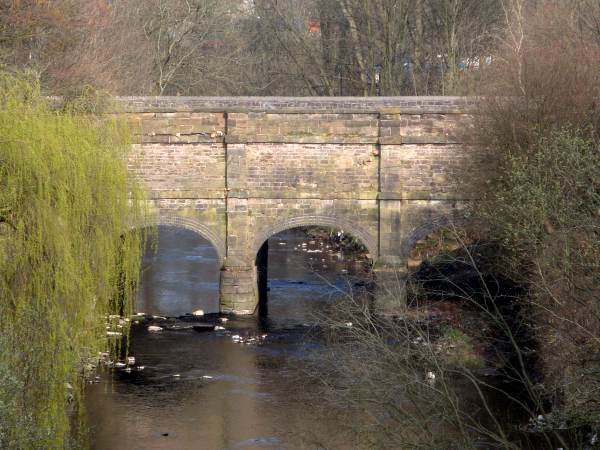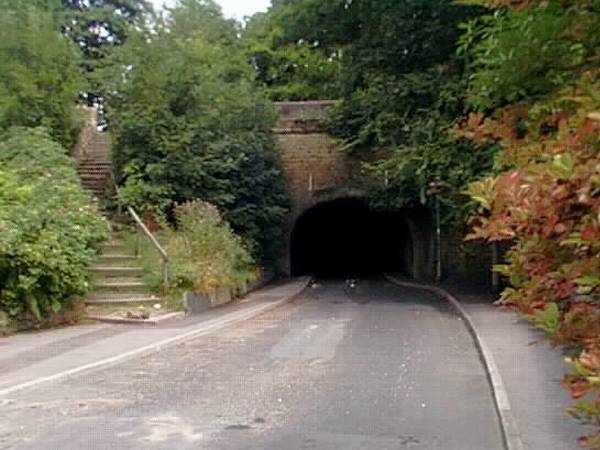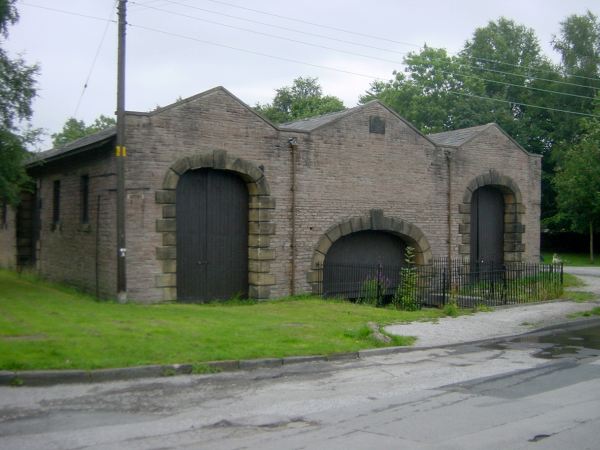In 1794 the Ashton Canal was being constructed between Manchester and Ashton under Lyne, with branches to Stockport and Hollinwood. The company wanted to add a further branch to the limestone quarries of the Peak District, but as they were in danger of taking on too many commitments, a separate company was set up.
The Peak Forest Canal Company had an Act of Parliament passed enabling them to construct a canal from the Ashton Canal's short branch crossing the Dukinfield aqueduct, to Chapel Milton, north of Chapel-en-le-Frith. A tramway would bring limestone to here from quarries between Peak Forest and Dove Holes.

Dukinfield Aqueduct, linking the Peak Forest canal to the Ashton Canal.
The canal would comprise two long level pounds separated by a flight of locks at Marple. The original plan was amended so that the canal terminated at Bugsworth, with several tramways running to a complex of basins there, and a short branch being constructed to Whaley Bridge.
The hilly nature of the landscape called for several tunnels and aqueducts, including one almost 100 feet high across the River Goyt and a major flight of locks at Marple, where the difference in height between the two level pounds was 209 feet. The company had at one time considered an inclined plane to carry smaller tub boats between the two levels, but this plan was quietly shelved.

Romiley Aqueduct, crossing Green Lane.
The construction of the canal was proving more costly than expected and it was decided to open the two level pounds in 1800, with an inclined tramway linking the two sections, replacing the flight of locks. This meant that the stone and other cargoes had to be carried in iron containers to enable easier transhipment between the boats and tramway wagons.
As the trade along the canal built up, the necessity of transhipping the cargo at each end of the tramway caused a frustrating bottleneck, even working at night, and eventually the funding was found to construct the flight of 16 locks to link the upper and lower pounds, which opened in 1804.
The engineer on the canal, Benjamin Outram, much in demand on other waterways in the area as well, designed what must surely be the highlight of the canal - the three arched aqueduct carrying the waterway 97 feet above the River Goyt, just north of the Marple locks. The company had considered a cheaper option of building an iron aqueduct, but went ahead with Outram's elegant masonry design with its spandrels or hollow tubes to reduce the weight on the piers.
One of the principle backers of the canal was Samuel Oldknow, who constructed lime kilns close to the top of the Marple locks (where a local road bears his name). Here, limestone from the Peak quarries was turned into lime for agriculture and building. Processed lime was loaded onto boats on a short arm which ran from a second arch alongside the Stockport Road bridge below Lock 13.
In 1831 the Macclesfield Canal was opened linking the top of the Marple locks with the Trent and Mersey Canal, increasing the traffic on the Peak Forest, which included some traffic between Manchester and London. In the same year, the Cromford and High Peak Railway opened, linking the Peak Forest Canal at Whaley Bridge with the Cromford Canal between Derby and Chesterfield. This railway had nine inclined planes and at first the wagons were pulled by horses.

The transhipment shed at Whaley Bridge, seen from the end facing away from the canal basin. A canal arm ran right through the centre while to each side are larger doors allowing railway wagons to enter.
For the next few years the canals prospered, carrying stone, coal, cotton, grain and manufactured goods, but this was to be short-lived as the canals became overtaken by the building of the railways.
In 1848, the Manchester, Sheffield and Lincolnshire Railway bought the Ashton, Peak Forest and Macclesfield Canals in order to feed goods into their railway system. This helped to keep the Peak Forest Canal active and the carrying of limestone continued to thrive, but traffic slowly declined into the early part of the twentieth century and the tramway from the quarries closed in 1925, giving the Peak Forest very little traffic south of the Macclesfield Canal junction.
The Marple locks, together with the Ashton Canal and lower level of the Peak Forest became neglected and difficult to navigate and by 1962 it began to look as if they might be officially closed. However, interest in using canals for leisure was growing and the Macclesfield and upper level of the Peak Forest began to attract craft for cruising.
In 1964, the Peak Forest Canal Society was formed and, with the Inland Waterways Association, fought to keep the Peak Forest and Ashton Canals open and to restore them. Their campaign led to the restoration of the Ashton Canal in 1974 and the re-opening of the Cheshire Ring of canals for leisure use.
In 1999, the Basins at Bugsworth (where the village is now known as Buxworth) were re-opened after extensive restoration, offering a tranquil mooring for narrowboats.
Sadly, serious leaks continued to affect the Bugsworth arm and it was closed again after only six months.
Major remedial work has been carried out and it is hoped that the arm and basins can be re-opened permanently.